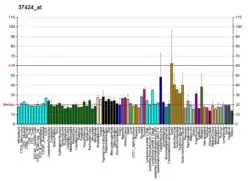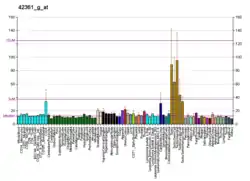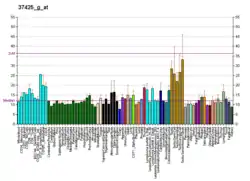CCHCR1
Coiled-coil alpha-helical rod protein 1, also known as CCHCR1, is a protein which in humans is encoded by the CCHCR1 gene.[5][6][7]
| CCHCR1 | |||||||||||||||||||||||||
|---|---|---|---|---|---|---|---|---|---|---|---|---|---|---|---|---|---|---|---|---|---|---|---|---|---|
| Identifiers | |||||||||||||||||||||||||
| Aliases | CCHCR1, C6orf18, HCR, SBP, coiled-coil alpha-helical rod protein 1, pg8 | ||||||||||||||||||||||||
| External IDs | OMIM: 605310 MGI: 2385321 HomoloGene: 10396 GeneCards: CCHCR1 | ||||||||||||||||||||||||
| |||||||||||||||||||||||||
| |||||||||||||||||||||||||
| |||||||||||||||||||||||||
| |||||||||||||||||||||||||
| Orthologs | |||||||||||||||||||||||||
| Species | Human | Mouse | |||||||||||||||||||||||
| Entrez | |||||||||||||||||||||||||
| Ensembl |
| ||||||||||||||||||||||||
| UniProt | |||||||||||||||||||||||||
| RefSeq (mRNA) | |||||||||||||||||||||||||
| RefSeq (protein) | |||||||||||||||||||||||||
| Location (UCSC) | Chr 6: 31.14 – 31.16 Mb | Chr 17: 35.52 – 35.53 Mb | |||||||||||||||||||||||
| PubMed search | [3] | [4] | |||||||||||||||||||||||
| Wikidata | |||||||||||||||||||||||||
| |||||||||||||||||||||||||
Gene
The Human CCHCR1 gene is located at 6p21.33. It is also known as Coiled-Coil Alphahelical Rod Protein 1, C6orf18, Putative Gene 8 Protein, SBP, HCR (A-Helix Coiled-Coil Rod Homologue), pg8, StAR-Binding Protein, and Pg8.
Homology
Homologes for CCHCR1 are conserved through tetrapods.
Orthologs
CCHCR1 has orthologs throughout vertebrates.
Phylogeny
Phylogenetic analysis with ClustalW indicated that CCHCR1
The CCHCR1 gene has
Protein
Structure
The structure of CCHCR1 is primarily composed of alpha-helices, coils, and a small amount of beta sheets, according to PELE.[8]
Function
May be a regulator of keratinocyte proliferation or differentiation.
Interacting Proteins
CCHCR1 has been shown to interact with POLR2C,[9] KRT17 ,[10] TOP3B,[11] Steroidogenic acute regulatory protein,[10] TRAF4,[12] HLA-C,[13] TCF19,[13] SNX29,[14] EEF1D,[15] and EEF1B2.[15]
Clinical significance
In genetically engineered mice, certain CCHCR1 polymorphisms cause upregulation of the expression of cytokeratins 6 (KRT6A), 16 (KRT16) and 17 (KRT17) and change in expression in other genes associated with terminal differentiation and formation of the cornified cell envelope. These CCHCR1 polymorphisms may therefore be associated with a susceptibility to psoriasis.[16] Defective functioning of CCHCR1 may lead to abnormal keratinocyte proliferation which is a key feature of psoriasis.[17]
CCHCR1 polymorphisms have also been found to be associated with multiple sclerosis.[18]
See also
References
- ENSG00000206355, ENSG00000224180, ENSG00000206457, ENSG00000223533, ENSG00000234114 GRCh38: Ensembl release 89: ENSG00000204536, ENSG00000206355, ENSG00000224180, ENSG00000206457, ENSG00000223533, ENSG00000234114 - Ensembl, May 2017
- GRCm38: Ensembl release 89: ENSMUSG00000040312 - Ensembl, May 2017
- "Human PubMed Reference:". National Center for Biotechnology Information, U.S. National Library of Medicine.
- "Mouse PubMed Reference:". National Center for Biotechnology Information, U.S. National Library of Medicine.
- "Entrez Gene: CCHCR1 coiled-coil alpha-helical rod protein 1".
- Asumalahti K, Laitinen T, Itkonen-Vatjus R, Lokki ML, Suomela S, Snellman E, Saarialho-Kere U, Kere J (June 2000). "A candidate gene for psoriasis near HLA-C, HCR (Pg8), is highly polymorphic with a disease-associated susceptibility allele". Hum. Mol. Genet. 9 (10): 1533–42. doi:10.1093/hmg/9.10.1533. PMID 10888604.
- Oka A, Tamiya G, Tomizawa M, Ota M, Katsuyama Y, Makino S, Shiina T, Yoshitome M, Iizuka M, Sasao Y, Iwashita K, Kawakubo Y, Sugai J, Ozawa A, Ohkido M, Kimura M, Bahram S, Inoko H (November 1999). "Association analysis using refined microsatellite markers localizes a susceptibility locus for psoriasis vulgaris within a 111 kb segment telomeric to the HLA-C gene". Hum. Mol. Genet. 8 (12): 2165–70. doi:10.1093/hmg/8.12.2165. PMID 10545595.
- Boudreau, A. E. (Mar 1999). "PELE—a version of the MELTS software program for the PC platform". Comput. Geosci. 25 (2): 201–203. Bibcode:1999CG.....25..201B. doi:10.1016/S0098-3004(98)00117-4. ISSN 0098-3004.
- Corbi N, Bruno T, De Angelis R, Di Padova M, Libri V, Di Certo MG, Spinardi L, Floridi A, Fanciulli M, Passananti C (September 2005). "RNA polymerase II subunit 3 is retained in the cytoplasm by its interaction with HCR, the psoriasis vulgaris candidate gene product". J. Cell Sci. 118 (Pt 18): 4253–60. doi:10.1242/jcs.02545. PMID 16141233.
- Tervaniemi MH, Siitonen HA, Söderhäll C, Minhas G, Vuola J, Tiala I, Sormunen R, Samuelsson L, Suomela S, Kere J, Elomaa O (2012). "Centrosomal localization of the psoriasis candidate gene product, CCHCR1, supports a role in cytoskeletal organization". PLOS ONE. 7 (11): e49920. Bibcode:2012PLoSO...749920T. doi:10.1371/journal.pone.0049920. PMC 3506594. PMID 23189171.
- Nicholas TJ, Baker C, Eichler EE, Akey JM (16 August 2011). "A high-resolution integrated map of copy number polymorphisms within and between breeds of the modern domesticated dog". BMC Genomics. 12: 414. doi:10.1186/1471-2164-12-414. PMC 3166287. PMID 21846351.
- Xu YC, Wu RF, Gu Y, Yang YS, Yang MC, Nwariaku FE, Terada LS (Aug 2002). "Involvement of TRAF4 in oxidative activation of c-Jun N-terminal kinase". The Journal of Biological Chemistry. 277 (31): 28051–7. doi:10.1074/jbc.M202665200. PMID 12023963.
- Petersdorf EW, Malkki M, Gooley TA, Spellman SR, Haagenson MD, Horowitz MM, Wang T (Jul 2012). "MHC-resident variation affects risks after unrelated donor hematopoietic cell transplantation". Science Translational Medicine. 4 (144): 144ra101. doi:10.1126/scitranslmed.3003974. PMC 3633562. PMID 22837536.
- Yang HH, Hu N, Wang C, Ding T, Dunn BK, Goldstein AM, Taylor PR, Lee MP (23 February 2010). "Influence of genetic background and tissue types on global DNA methylation patterns". PLOS ONE. 5 (2): e9355. Bibcode:2010PLoSO...5.9355Y. doi:10.1371/journal.pone.0009355. PMC 2826396. PMID 20186319.
- Corbi N, Batassa EM, Pisani C, Onori A, Di Certo MG, Strimpakos G, Fanciulli M, Mattei E, Passananti C (31 December 2010). "The eEF1γ subunit contacts RNA polymerase II and binds vimentin promoter region". PLOS ONE. 5 (12): e14481. Bibcode:2010PLoSO...514481C. doi:10.1371/journal.pone.0014481. PMC 3013090. PMID 21217813.
- Elomaa O, Majuri I, Suomela S, Asumalahti K, Jiao H, Mirzaei Z, Rozell B, Dahlman-Wright K, Pispa J, Kere J, Saarialho-Kere U (August 2004). "Transgenic mouse models support HCR as an effector gene in the PSORS1 locus". Hum. Mol. Genet. 13 (15): 1551–61. doi:10.1093/hmg/ddh178. PMID 15190014.
- Tiala I, Wakkinen J, Suomela S, Puolakkainen P, Tammi R, Forsberg S, Rollman O, Kainu K, Rozell B, Kere J, Saarialho-Kere U, Elomaa O (April 2008). "The PSORS1 locus gene CCHCR1 affects keratinocyte proliferation in transgenic mice". Hum. Mol. Genet. 17 (7): 1043–51. doi:10.1093/hmg/ddm377. PMID 18174193.
- Lin X, Deng FY, Lu X, Lei SF (2015). "Susceptibility Genes for Multiple Sclerosis Identified in a Gene-Based Genome-Wide Association Study". Journal of Clinical Neurology. 11 (4): 311–8. doi:10.3988/jcn.2015.11.4.311. PMC 4596110. PMID 26320842.
External links
- Human CCHCR1 genome location and CCHCR1 gene details page in the UCSC Genome Browser.
Further reading
- Adams MD, Kerlavage AR, Fleischmann RD, Fuldner RA, Bult CJ, Lee NH, Kirkness EF, Weinstock KG, Gocayne JD, White O (1995). "Initial assessment of human gene diversity and expression patterns based upon 83 million nucleotides of cDNA sequence" (PDF). Nature. 377 (6547 Suppl): 3–174. PMID 7566098.
- Oka A, Tamiya G, Tomizawa M, Ota M, Katsuyama Y, Makino S, Shiina T, Yoshitome M, Iizuka M, Sasao Y, Iwashita K, Kawakubo Y, Sugai J, Ozawa A, Ohkido M, Kimura M, Bahram S, Inoko H (1999). "Association analysis using refined microsatellite markers localizes a susceptibility locus for psoriasis vulgaris within a 111 kb segment telomeric to the HLA-C gene". Hum. Mol. Genet. 8 (12): 2165–70. doi:10.1093/hmg/8.12.2165. PMID 10545595.
- Asumalahti K, Laitinen T, Itkonen-Vatjus R, Lokki ML, Suomela S, Snellman E, Saarialho-Kere U, Kere J (2000). "A candidate gene for psoriasis near HLA-C, HCR (Pg8), is highly polymorphic with a disease-associated susceptibility allele". Hum. Mol. Genet. 9 (10): 1533–42. doi:10.1093/hmg/9.10.1533. PMID 10888604.
- O'Brien KP, Holm SJ, Nilsson S, Carlén L, Rosenmüller T, Enerbäck C, Inerot A, Ståhle-Bäckdahl M (2001). "The HCR gene on 6p21 is unlikely to be a psoriasis susceptibility gene". J. Invest. Dermatol. 116 (5): 750–4. doi:10.1046/j.0022-202x.2001.01323.x. PMID 11348465.
- Asumalahti K, Veal C, Laitinen T, Suomela S, Allen M, Elomaa O, Moser M, de Cid R, Ripatti S, Vorechovsky I, Marcusson JA, Nakagawa H, Lazaro C, Estivill X, Capon F, Novelli G, Saarialho-Kere U, Barker J, Trembath R, Kere J (2002). "Coding haplotype analysis supports HCR as the putative susceptibility gene for psoriasis at the MHC PSORS1 locus". Hum. Mol. Genet. 11 (5): 589–97. doi:10.1093/hmg/11.5.589. PMID 11875053.
- Xu YC, Wu RF, Gu Y, Yang YS, Yang MC, Nwariaku FE, Terada LS (2002). "Involvement of TRAF4 in oxidative activation of c-Jun N-terminal kinase". J. Biol. Chem. 277 (31): 28051–7. doi:10.1074/jbc.M202665200. PMID 12023963.
- Sugawara T, Shimizu H, Hoshi N, Nakajima A, Fujimoto S (2003). "Steroidogenic acute regulatory protein-binding protein cloned by a yeast two-hybrid system". J. Biol. Chem. 278 (43): 42487–94. doi:10.1074/jbc.M302291200. PMID 12909641.
- Suomela S, Elomaa O, Asumalahti K, Kariniemi AL, Karvonen SL, Peltonen J, Kere J, Saarialho-Kere U (2003). "HCR, a candidate gene for psoriasis, is expressed differently in psoriasis and other hyperproliferative skin disorders and is downregulated by interferon-gamma in keratinocytes". J. Invest. Dermatol. 121 (6): 1360–4. doi:10.1046/j.1523-1747.2003.12642.x. PMID 14675183.
- Brandenberger R, Wei H, Zhang S, Lei S, Murage J, Fisk GJ, Li Y, Xu C, Fang R, Guegler K, Rao MS, Mandalam R, Lebkowski J, Stanton LW (2004). "Transcriptome characterization elucidates signaling networks that control human ES cell growth and differentiation". Nat. Biotechnol. 22 (6): 707–16. doi:10.1038/nbt971. PMID 15146197. S2CID 27764390.
- Lim J, Hao T, Shaw C, Patel AJ, Szabó G, Rual JF, Fisk CJ, Li N, Smolyar A, Hill DE, Barabási AL, Vidal M, Zoghbi HY (2006). "A protein-protein interaction network for human inherited ataxias and disorders of Purkinje cell degeneration". Cell. 125 (4): 801–14. doi:10.1016/j.cell.2006.03.032. PMID 16713569. S2CID 13709685.
- Chang J, Nicolas E, Marks D, Sander C, Lerro A, Buendia MA, Xu C, Mason WS, Moloshok T, Bort R, Zaret KS, Taylor JM (2004). "miR-122, a mammalian liver-specific microRNA, is processed from hcr mRNA and may downregulate the high affinity cationic amino acid transporter CAT-1". RNA Biol. 1 (2): 106–13. doi:10.4161/rna.1.2.1066. PMID 17179747.
- Tiala I, Suomela S, Huuhtanen J, Wakkinen J, Hölttä-Vuori M, Kainu K, Ranta S, Turpeinen U, Hämäläinen E, Jiao H, Karvonen SL, Ikonen E, Kere J, Saarialho-Kere U, Elomaa O (2007). "The CCHCR1 (HCR) gene is relevant for skin steroidogenesis and downregulated in cultured psoriatic keratinocytes". J. Mol. Med. 85 (6): 589–601. doi:10.1007/s00109-006-0155-0. PMID 17221218. S2CID 25864002.
- Suomela S, Kainu K, Onkamo P, Tiala I, Himberg J, Koskinen L, Snellman E, Karvonen SL, Karvonen J, Uurasmaa T, Reunala T, Kivikäs K, Jansén CT, Holopainen P, Elomaa O, Kere J, Saarialho-Kere U (2007). "Clinical associations of the risk alleles of HLA-Cw6 and CCHCR1*WWCC in psoriasis". Acta Derm. Venereol. 87 (2): 127–34. doi:10.2340/00015555-0184. PMID 17340018.
- Elomaa O, Majuri I, Suomela S, Asumalahti K, Jiao H, Mirzaei Z, Rozell B, Dahlman-Wright K, Pispa J, Kere J, Saarialho-Kere U (Aug 2004). "Transgenic mouse models support HCR as an effector gene in the PSORS1 locus". Human Molecular Genetics. 13 (15): 1551–61. doi:10.1093/hmg/ddh178. PMID 15190014.






